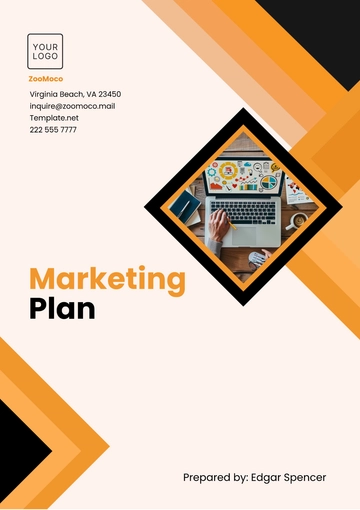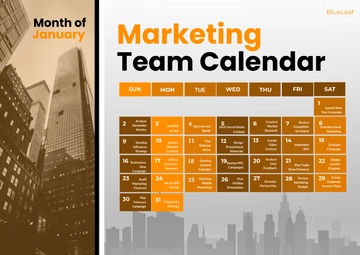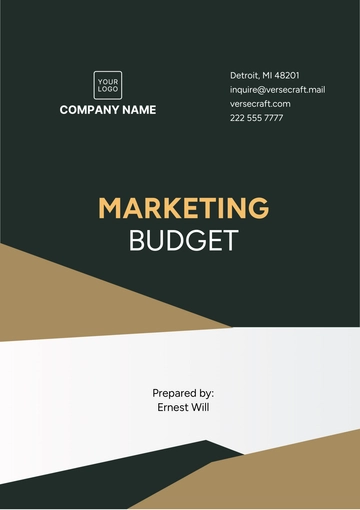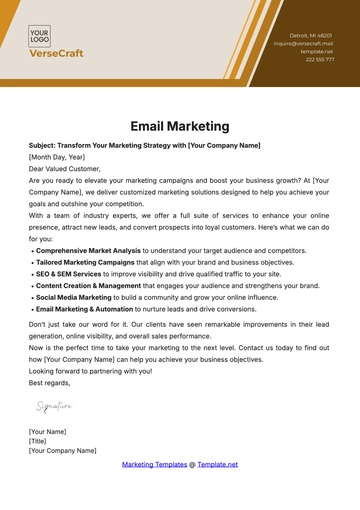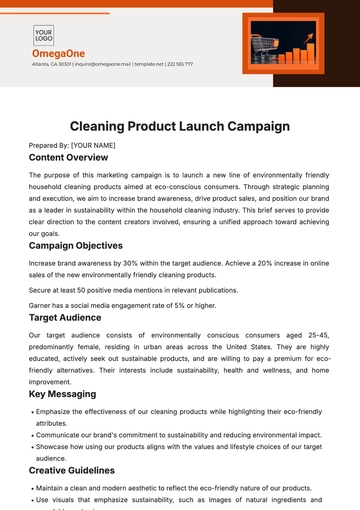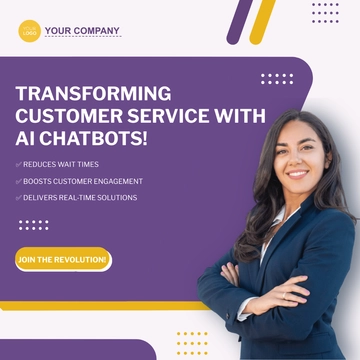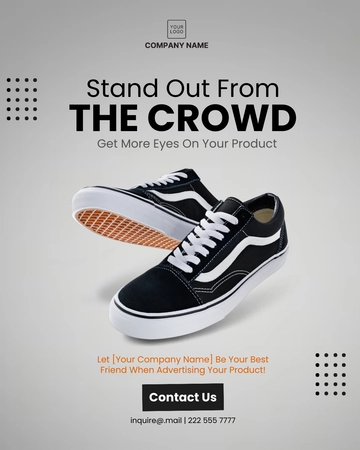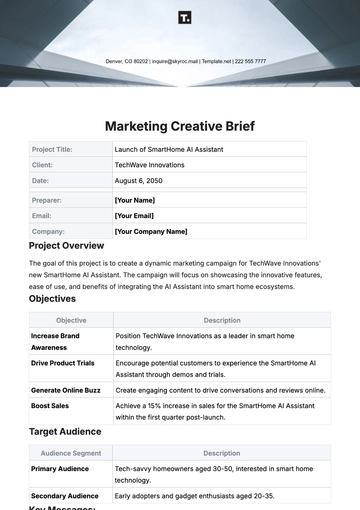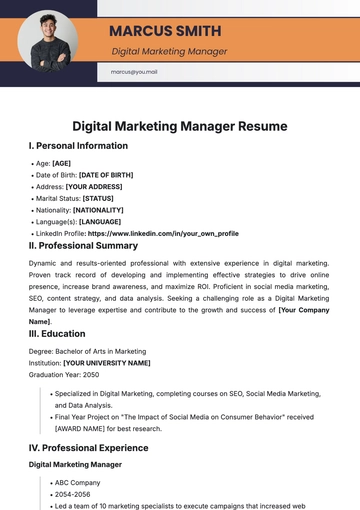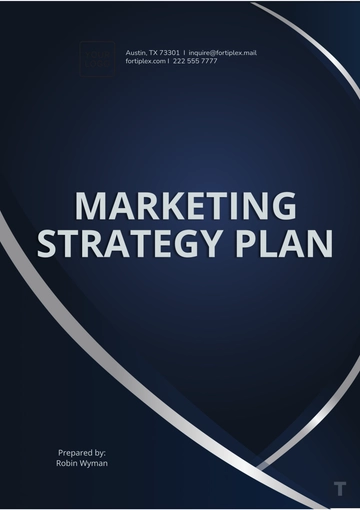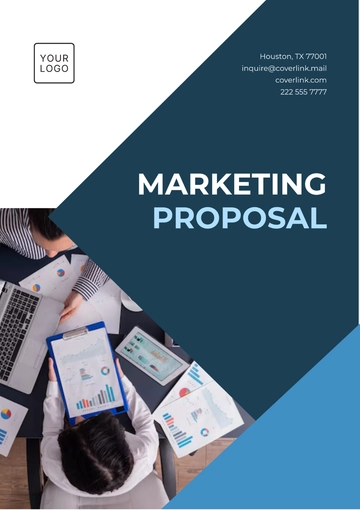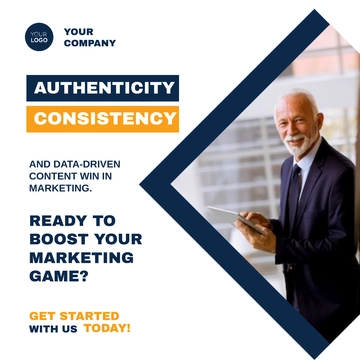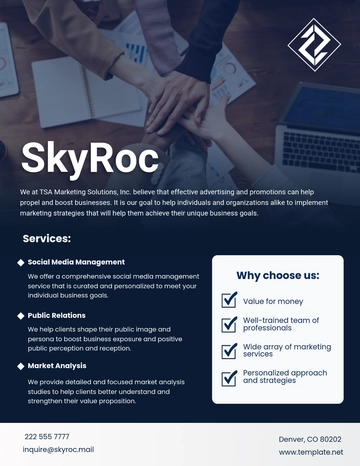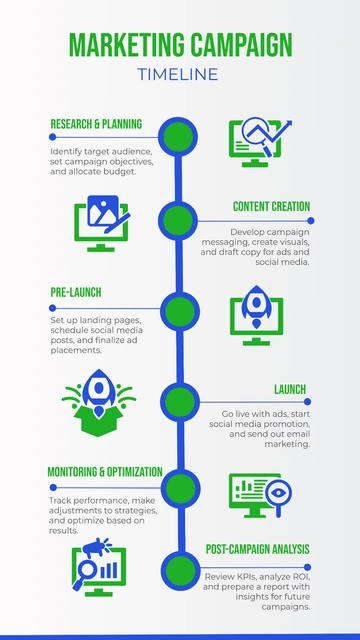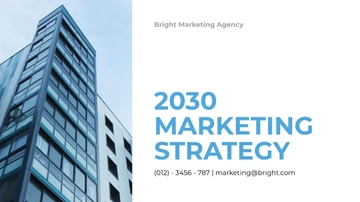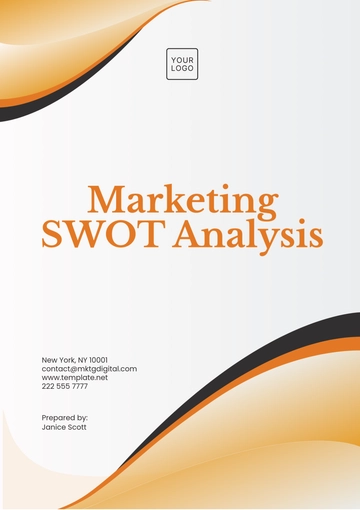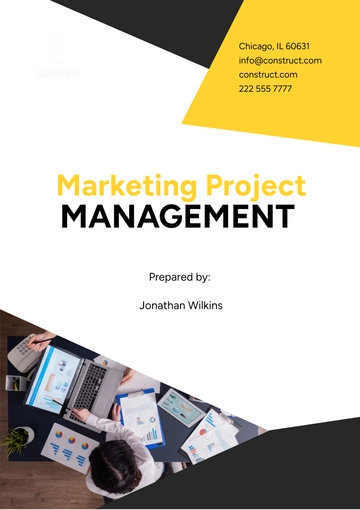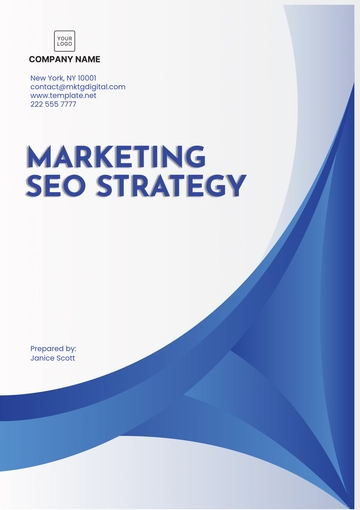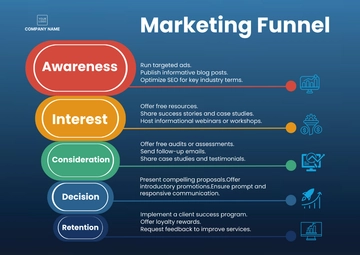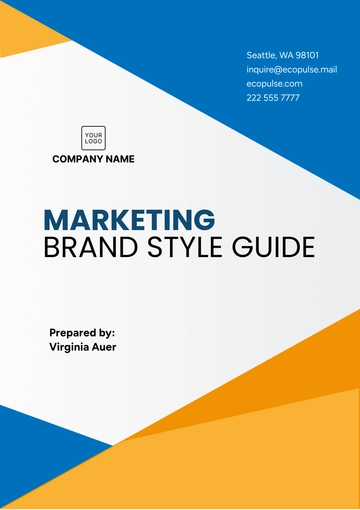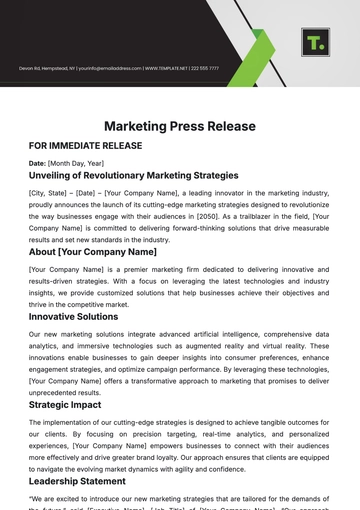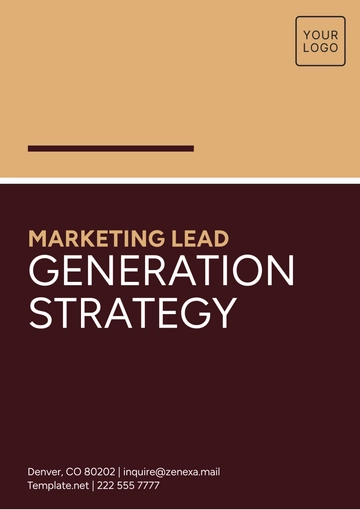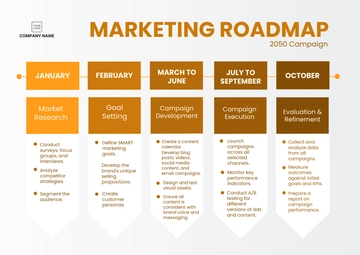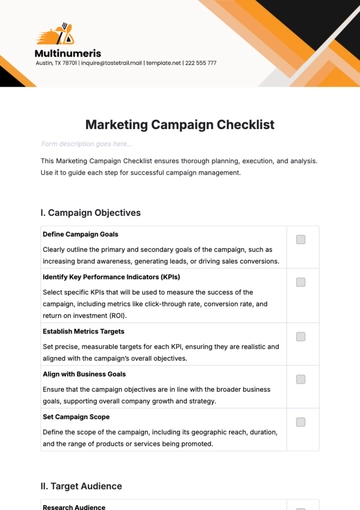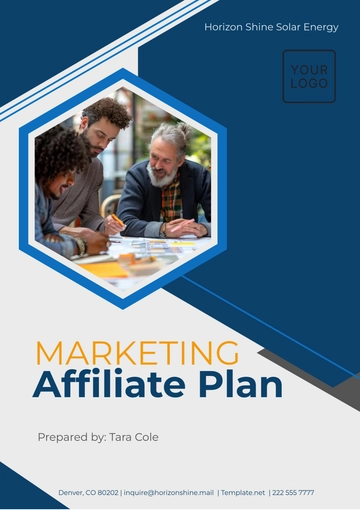Free Media Marketing Strategy
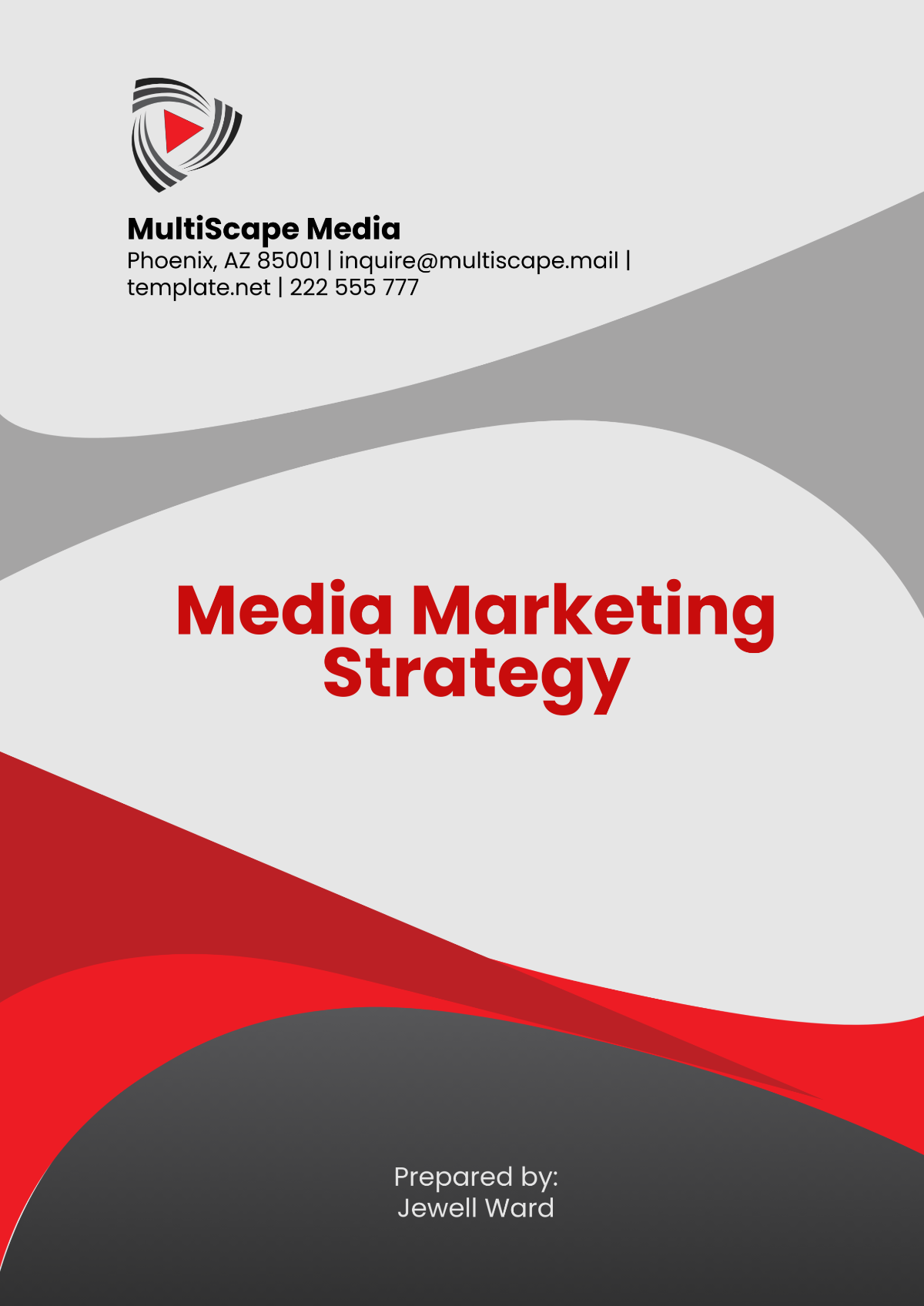
I. Introduction
In the digital-first world of the 2050s, the landscape of marketing is rapidly evolving. Companies must adapt to new technologies, changing consumer behavior, and innovative advertising platforms to maintain relevance and sustain growth. A comprehensive media marketing strategy is essential for any organization looking to increase its brand visibility, drive customer engagement, and boost conversions. This document outlines the strategic plan for [Your Company Name] to effectively navigate this complex media environment and achieve its business objectives.
The strategy presented herein covers all aspects of media marketing, including platform selection, content creation, budget allocation, performance tracking, and more. As we look ahead to the next decade, it is important for [Your Company Name] to remain agile, responsive, and forward-thinking to capture new opportunities and address emerging challenges.
II. Objectives of the Media Marketing Strategy
A. General Objectives
Increase Brand Awareness
One of the core goals of any media marketing strategy is to increase brand awareness. This objective focuses on positioning [Your Company Name] as a leading brand within its industry, ensuring it stands out in the crowded digital marketplace. In an era where consumers are exposed to a high volume of advertisements, developing a clear, consistent, and compelling brand message is crucial. Our strategy will include multiple media channels to ensure that we reach the right audience at the right time.Boost Consumer Engagement
Engaging consumers goes beyond simply making sales—it's about building long-term relationships and establishing trust. [Your Company Name] will focus on creating engaging and interactive content that resonates with our audience. Through social media, email marketing, and other platforms, we aim to generate two-way communication with consumers, responding to their needs, questions, and feedback.Drive Conversions
Ultimately, the purpose of our media marketing efforts is to convert interest into action. Whether through direct sales, lead generation, or other desired actions, our campaigns will focus on driving measurable outcomes. This objective is closely linked with creating highly targeted campaigns that guide prospects through the customer journey, from awareness to purchase.
B. Specific Objectives
Increase Website Traffic
Aiming for a [30]% increase in website traffic by the end of [2052] will be one of our primary goals. This will be achieved through a combination of organic search engine optimization (SEO), paid search advertising, and content marketing strategies. Our goal is to increase our organic presence by creating relevant, high-quality content that speaks to the interests and needs of our audience.Generate New Leads
Lead generation is essential for any business looking to grow its customer base. By targeting the right audience segments and providing them with compelling offers, we aim to generate [5,000] new leads each quarter starting from Q1 [2051]. This will be accomplished through lead magnets, landing pages, and lead nurturing campaigns across multiple channels.Increase Sales Revenue
Our goal is to achieve a [20]% growth in sales revenue from digital campaigns within the next [two years]. To do so, we will utilize data-driven strategies to optimize our conversion rates, ensure a seamless user experience, and continuously analyze performance to identify areas for improvement.
III. Target Audience Analysis
A thorough understanding of our target audience is essential for the success of our media marketing strategy. By identifying the key characteristics of our ideal customer, we can tailor our content, messaging, and advertising efforts to meet their needs and preferences.
A. Demographics
Our target audience can be broadly described using the following demographics:
Parameter | Details |
|---|---|
Age Range | 25–45 years |
Gender | All genders |
Income Level | $50,000–$150,000 annually |
Location | Primarily urban and suburban areas |
Education Level | Bachelor's degree or higher |
This demographic profile represents a well-educated, tech-savvy audience who is typically employed in professional roles. They are likely to be socially conscious, value innovation, and have a higher disposable income, allowing them to make informed purchasing decisions.
B. Psychographics
In addition to demographic characteristics, understanding the psychographics of our target audience is crucial for developing content that resonates with their values and interests.
Interests:
Our audience is interested in sustainability, technology, and lifestyle improvement. Many are early adopters of new technologies and trends, particularly in areas like health, wellness, and environmental responsibility. They value brands that align with their personal values, especially when it comes to ethical and eco-friendly business practices.Values:
The target audience prioritizes innovation, convenience, and social responsibility. They want brands to demonstrate genuine commitment to societal issues, such as environmental sustainability, social justice, and ethical production practices. [Your Company Name] can leverage these values to build trust and deepen engagement with the audience.Behavior:
Our audience is active on social media platforms, especially Instagram, LinkedIn, and Facebook. They are highly engaged in online communities, often interacting with brands directly through comments, messages, and shares. Many of them are frequent online shoppers and seek out reviews, ratings, and recommendations before making purchasing decisions. Our strategy will include leveraging social proof to influence purchasing decisions.
C. Personas
To make our marketing efforts more targeted and personalized, we have developed the following customer personas:
"Tech-Savvy Professional":
This persona represents individuals who are interested in cutting-edge technologies and solutions that improve their productivity and quality of life. They are often looking for products or services that save them time, simplify tasks, or enhance their performance. These individuals tend to be highly educated, with busy lifestyles that demand efficiency."Conscious Consumer":
This persona embodies individuals who care deeply about sustainability, ethics, and corporate responsibility. They are more likely to choose products or services that align with their values, such as eco-friendly packaging, fair trade sourcing, or a company’s commitment to reducing its carbon footprint. Engaging this audience requires messaging that highlights our sustainable practices and positive impact on society.
IV. Media Platforms
Selecting the right media platforms is a critical part of our media marketing strategy. We will focus on a mix of owned, paid, and earned media to ensure we reach our target audience through various touchpoints.
A. Owned Media
Company Website
The website will serve as the central hub for all of our marketing efforts. It must be optimized for both search engines and user experience (UX) to drive traffic and increase engagement. We will regularly update the website with fresh, relevant content, including blog posts, case studies, and product pages, to keep visitors engaged and coming back.Email Marketing
Email marketing is one of the most cost-effective ways to communicate directly with our audience. We will send bi-weekly newsletters, featuring company updates, educational content, product promotions, and exclusive offers. Additionally, we will use email segmentation to ensure that we deliver personalized content to different customer groups, based on their interests and behaviors.Mobile App
Our mobile app will serve as a tool to increase engagement and provide a seamless shopping experience. It will offer features such as loyalty programs, push notifications for product updates, and personalized content based on user preferences. By incentivizing app downloads, we can further integrate our brand into the daily lives of our customers.
B. Paid Media
Search Engine Advertising (SEA)
Paid search ads, particularly through Google Ads, will help us target potential customers who are actively searching for products or services that we offer. We will invest a significant portion of our budget in pay-per-click (PPC) campaigns to drive immediate traffic to our website. These ads will target high-conversion keywords and be continually optimized for maximum return on investment (ROI).Social Media Advertising
Social media platforms, such as Instagram, Facebook, and LinkedIn, will be a key channel for promoting our products and building brand awareness. We will create engaging ads tailored to each platform, leveraging visuals, videos, and audience targeting tools. The goal is to drive traffic to our website, increase lead generation, and foster deeper relationships with our customers.
C. Earned Media
Social Media Shares
Social media shares are a valuable form of earned media. We will encourage our customers to share their experiences with [Your Company Name] by running social media contests, offering incentives for sharing content, and creating shareable, engaging content. These efforts will help expand our reach and credibility.Public Relations (PR)
PR efforts, such as press releases, media interviews, and collaborations with influencers, will help enhance our brand’s credibility and visibility. We will aim to establish [Your Company Name] as a thought leader within our industry through expert commentary and by participating in relevant industry events and discussions.
V. Content Strategy
A. Types of Content
The content we create will be varied and tailored to meet the needs and preferences of our target audience. Below is a breakdown of the different types of content we will produce:
Content Type | Purpose | Frequency |
|---|---|---|
Blog Posts | To increase organic traffic and educate our audience | Weekly |
Social Media Posts | To engage users and drive traffic | Daily |
Infographics | To simplify complex data and increase shareability | Bi-Monthly |
Video Content | To engage the audience and demonstrate products | Weekly |
Webinars | To educate the audience and position [Your Company Name] as an authority | Quarterly |
We will maintain a consistent posting schedule to ensure that our content reaches the right people at the right time. All content will be designed to be engaging, informative, and aligned with our brand's values.
B. Storytelling and Branding
Storytelling will be a key component of our content strategy. We aim to craft compelling narratives that resonate with our target audience and highlight the values and mission of [Your Company Name]. By sharing authentic stories that showcase the human side of our brand, we can create deeper emotional connections with our customers. These stories will focus on our sustainability efforts, product innovations, and the positive impact we have on society.
VI. Budget Allocation
A well-defined budget is crucial to ensure that our media marketing efforts are both effective and efficient. Below is a detailed breakdown of how we will allocate our marketing budget:
A. Annual Media Marketing Budget
Category | Allocation ($) | Percentage (%) |
|---|---|---|
Social Media Ads | 500,000 | 40 |
Content Creation | 300,000 | 25 |
SEO and SEA | 200,000 | 15 |
Analytics Tools | 150,000 | 12 |
Miscellaneous Expenses | 50,000 | 8 |
Total | 1,200,000 | 100 |
B. Cost Breakdown Example for Q1 [2051]
Platform | Budget ($) |
|---|---|
50,000 | |
Google Ads | 30,000 |
20,000 |
These budget allocations will be reviewed quarterly to ensure that we are optimizing spending and achieving the desired results. We will focus on high-ROI channels and adjust spending based on campaign performance.
VII. Key Performance Indicators (KPIs)
To measure the success of our media marketing strategy, we will track the following KPIs:
Metric | Target | Timeline |
|---|---|---|
Website Traffic | 30% increase | 2052 |
Conversion Rate | 5% increase | 12 months |
Social Media Engagement | 15,000 interactions/month | Starting 2051 |
Email Open Rate | Maintain above 25% | Ongoing |
These KPIs will be monitored regularly, and adjustments will be made to our strategy as needed to ensure that we are on track to meet our goals.
VIII. Implementation Plan
A. Timeline
The following timeline outlines the key phases of our media marketing strategy:
Phase | Timeline | Activities |
|---|---|---|
Research & Planning | Q1 2050 | Audience analysis, tool setup |
Campaign Launch | Q2 2050 | Deploy paid ads, launch content |
Optimization | Q3 2050 | Adjust based on metrics |
Scale and Sustain | Q4 2050 onwards | Expand campaigns, evaluate ROI |
B. Team Roles
The following team members will be responsible for executing this strategy:
Role | Responsibilities |
|---|---|
Marketing Manager | Oversee strategy implementation |
Content Creator | Develop engaging materials |
Data Analyst | Monitor KPIs and optimize campaigns |
IX. Risk Assessment and Mitigation
Despite careful planning, there are always risks involved in media marketing campaigns. The following are potential risks and how we plan to mitigate them:
A. Common Risks
Platform Algorithm Changes
Platforms like Instagram and Facebook regularly update their algorithms, which can impact organic reach. To mitigate this risk, we will diversify our media efforts, balancing organic posts with paid advertisements. Staying informed about changes and adjusting our approach quickly will help minimize disruption.Budget Overruns
Exceeding our marketing budget could affect profitability. To avoid this, we will establish clear performance metrics for each campaign and regularly monitor expenses. If any channel underperforms, we will reallocate funds to higher-performing areas.Negative Feedback
Negative feedback from customers can harm a brand's reputation. We will create a proactive customer service strategy to address complaints quickly and effectively. Our social media team will respond promptly to negative comments and ensure that our customer service standards are consistently upheld.
X. Future Trends and Innovations
A. Artificial Intelligence (AI) in Marketing
The role of AI in marketing is expected to grow exponentially by 2050. AI will play a key role in personalizing content for individual users, predicting consumer behavior, and automating aspects of campaign management. By leveraging AI-driven tools, [Your Company Name] can increase efficiency and deliver highly tailored experiences to customers.
B. Immersive Technologies
The use of augmented reality (AR) and virtual reality (VR) is becoming more mainstream, and we expect these technologies to play a key role in customer engagement. Through immersive experiences, we can allow customers to try products virtually or explore our brand in new and exciting ways. These technologies will help create deeper emotional connections with consumers.
C. Sustainability in Marketing
As sustainability continues to be a priority for consumers, our marketing efforts will highlight our commitment to environmentally friendly practices. By showcasing our efforts to reduce our carbon footprint, use sustainable materials, and engage in ethical sourcing, we will build trust and attract environmentally conscious customers.
XI. Conclusion
This media marketing strategy for [Your Company Name] offers a clear roadmap for achieving our business goals over the next decade. By leveraging a mix of owned, paid, and earned media, focusing on audience engagement, and optimizing performance through data analytics, we are well-positioned to succeed in the rapidly changing digital landscape. Our commitment to continuous improvement and adaptability will ensure that [Your Company Name] remains a strong, relevant brand in [2050] and beyond.
- 100% Customizable, free editor
- Access 1 Million+ Templates, photo’s & graphics
- Download or share as a template
- Click and replace photos, graphics, text, backgrounds
- Resize, crop, AI write & more
- Access advanced editor
Develop impactful campaigns with the Media Marketing Strategy Template from Template.net. This editable and customizable template provides a framework to plan, execute, and evaluate your marketing efforts. Tailor your strategy using the AI Editor Tool for maximum effectiveness.
You may also like
- Marketing Google Slide
- Marketing Letter
- Marketing Quotation
- Marketing Report
- Marketing Strategic Plan
- Marketing Plan
- Marketing Proposal
- Marketing Flyer
- Marketing Presentation
- Real Estate Marketing Plan
- Marketing Contract
- Marketing Agreement
- Marketing Resume
- Marketing Checklist
- Marketing Brochure
- Marketing Banner
- Marketing Schedule
- Marketing Vector
- Marketing Logo
- Marketing Chart
- Marketing Campaign Plan
- Marketing Budget
- Marketing Postcard
- Marketing Poster
- Marketing Facebook Post
- Marketing Instagram Post
- Marketing Newsletter
- Marketing Infographic
